Texas flood occurred in county with no system to warn visitors to evacuate
Kerr County balked at system's cost
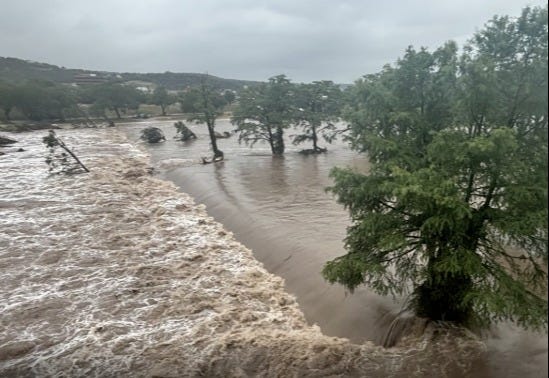
(NOTE: In light of Kerr County having no warning system along the flood-prone stretch of the Guadalupe River, this article has been updated to include information about a warning system that is in place downriver in nearby Comal County. The Associated Press has since reported that Kerr County also considered installing a similar warning system, but that its County Judge says “the idea never got off the ground and the cost would have been an issue.” )
A wave of misinformation that people had no warning before flood waters hit the Texas Hill Country during the July 4th holiday weekend has appeared online after the head of the impacted county spoke to reporters, where more than 65 people have died, and 12 children and a counselor are still missing from a girl’s camp along the Guadalupe River.
There's ample evidence that not only were warnings issued, but there was also no system in place for local authorities to warn those along the river.
In Kerr County, County Judge Robert Kelly is the highest locally elected official. “We do not have a warning system”, he explained.
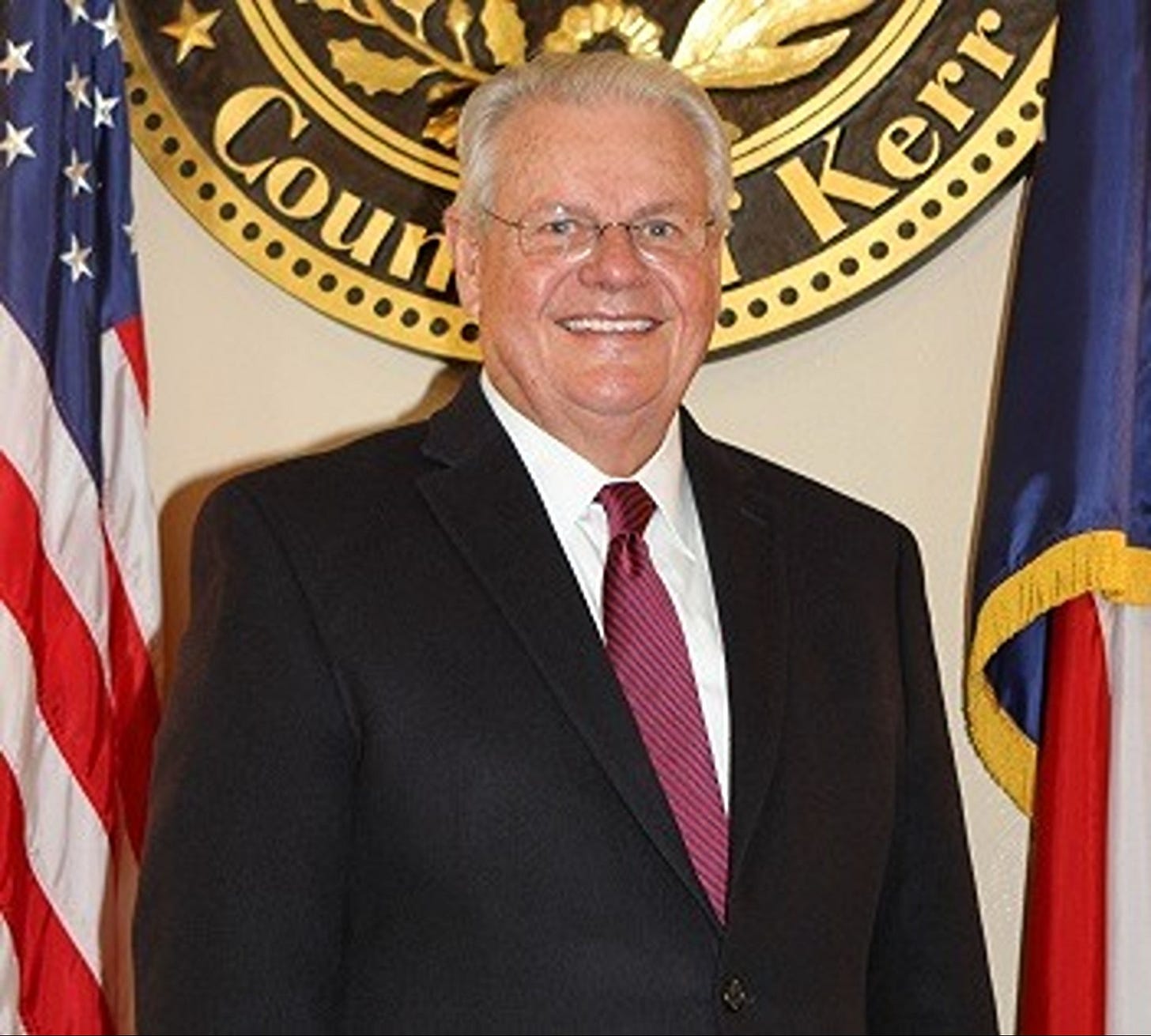
"Rest assured, no one knew this kind of a flood was coming," Judge Kelly told reporters, then added: "We have floods all the time. This is the most dangerous river valley in the United States. And we deal with floods on a regular basis. When it rains, we get water, " said Judge Kelly before saying "We had no reason to believe that this was gonna be anything like what happened here.”
W. Nim Kidd, Chief of the Texas Division of Emergency Management, complained about the weather forecast that officials relied upon to make preparations. “Everybody got the forecast from the National Weather Service, right? You all got it, you’re all in media, you got that forecast. It did not predict the amount of rain that we saw,” Kidd said.
People on X.com rushed to heap blame on the National Weather Service:
The last post about "Camp Mystic" addresses the larger tragedy associated with the Kerr County Floods.
Camp Mystic is a Christian Camp on the Guadalupe River where more than 20 girls are missing after floodwaters swept away their cabins.
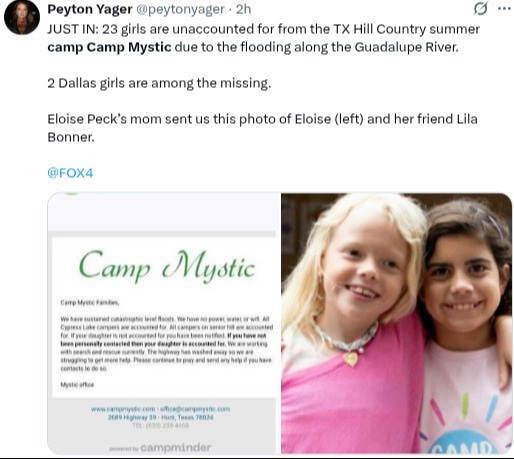
Asked why the camps along the river were not evacuated, Kerr County Judge Ron Kelly said, “I can’t answer that. I don’t know.”
That answer is concerning, considering that more than 35 years ago, an eerily similar tragedy occurred in Kerr County when flash floodwaters on the same river inundated Christian campers at the Pot O’ Gold Ranch, which was hosting 300 children. Thirty-three were pulled from the river, but ten teenagers drowned.
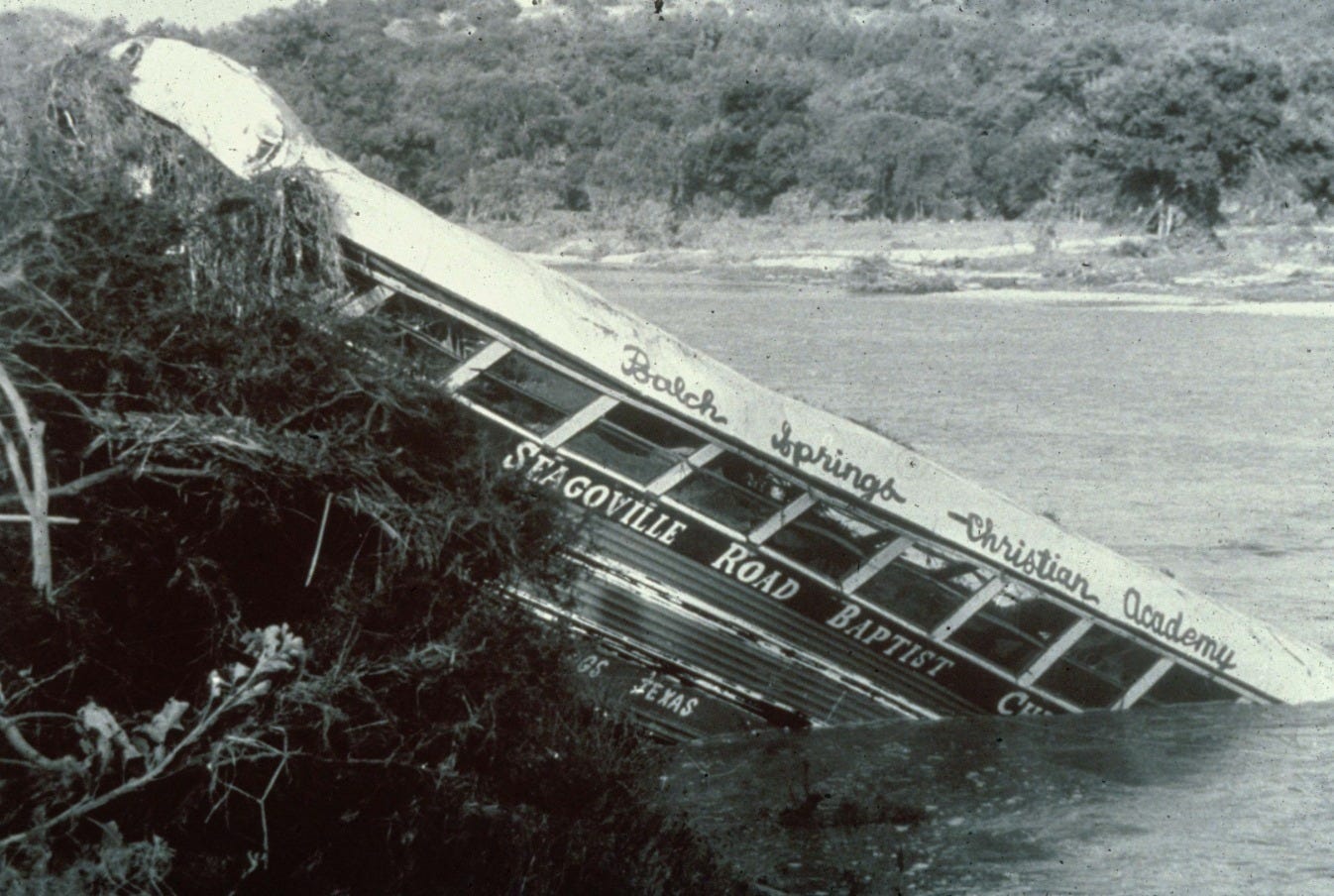
Now, let's look at what the National Weather Service did to warn the county about these latest storms.
The day before the July 4, 2025, floods occurred, the National Weather Service issued a Flash Flood Watch for the area through the next morning (when the fatal flooding happened).

Shortly after midnight, national forecasters began sounding the alarm about the developing flood dangers within the Texas Hill Country (including Kerr County).
Minutes later, local forecasters advised that the situation in the Hill Country was worsening:

An hour after midnight, the National Weather Service's Austin/San Antonio office issued a warning that "very heavy rainfall" was falling in Kerr County, within the Flash Flood Watch Area they had designated more than 10 hours prior.
At 1:14 AM, the National Weather Service began issuing Flash Flood Warnings for Kerr County:
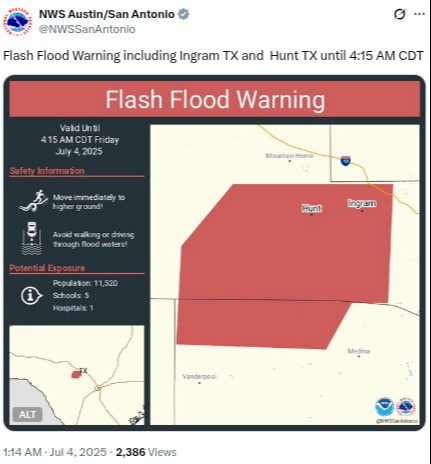
A cascading series of warnings & advisories followed, with the National Weather Service declaring the situation to be a "Particularly Dangerous Situation" and a "Flash Flood Emergency" for Kerr County shortly after 4:00 AM:
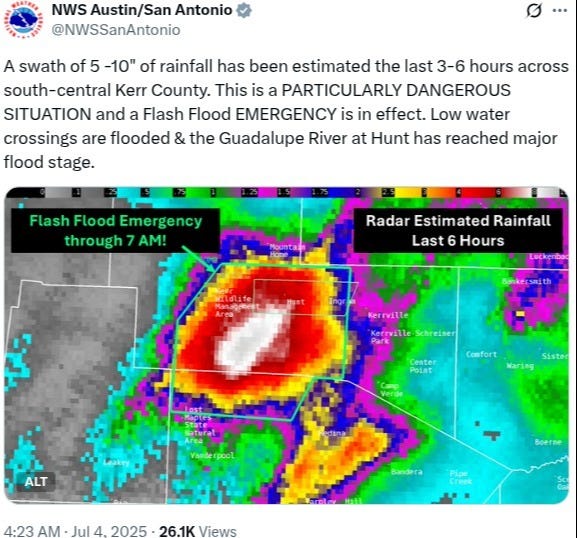
By 6:00 AM, floodwaters were washing away Guadalupe River campgrounds in Kerr County as well as cabins and river neighborhoods packed with Fourth of July vacationers and people from outside the area, unaware of the dangers they faced in a county that had not implemented a flood warning system, despite a historic flash flood that had killed ten teens there more than thirty-five years ago.

A National Weather Service graphic shows the Guadalupe River in Kerr County rising almost 30 feet during the Kerr County flooding episode—the second-highest floods recorded there in modern history.
(As for why the forecasts did not include the catastrophic rainfall levels that did occur, over at The Eyewall on Substack, Texas Meteorologist Matt Landa offers informative analysis).

In an area County Judge Kelly admits "is the most dangerous river valley in the United States" (and where they saw this deadly scenario more than 35 years ago), it’s fair to ask why an outdoor warning system (such as sirens) has not been built along the river to warn people to flee to high ground.
It’s not unheard of in Texas.
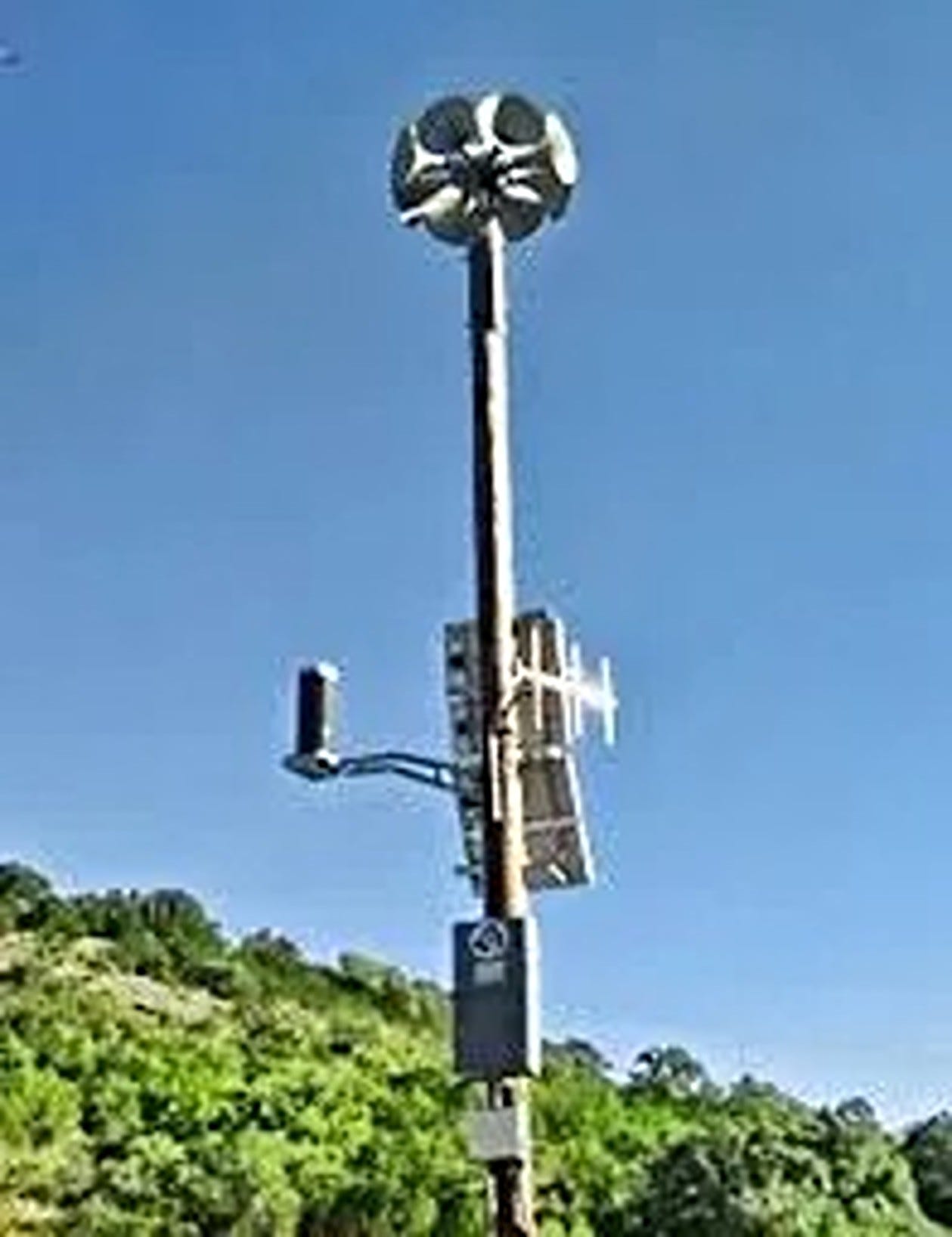
Two counties downstream of Kerr County, warning sirens have been installed in Comal County along the Guadalupe River from Canyon Lake to New Braunfels. This flood-prone 24-mile stretch also attracts large numbers of visitors for recreational activities like tubing, kayaking, and canoeing. The sirens, which are linked to automatic flood gauges on the river, have been in place for almost ten years.
UPDATE: The Associated Press reports that “(Kerr) county had considered a flood warning system on the river similar to a tornado warning siren about six or seven years ago, but Kelly said the idea never got off the ground and the cost would have been an issue.”
Meanwhile, other flood-prone Texas communities have invested in similar systems.
In DFW, the suburb of Grand Prairie has also installed flood warning sirens in areas within a 100-year floodplain.

UPDATE: Elsewhere on Substack, The Rural Texas Reporter writes that Kerr County’s State Representative voted against a bill that “would have provided funding to counties like Kerr to purchase sirens or other emergency alert equipment, which might have provided the warning the communities needed to avoid the massive loss of lives.”
It’s also important to note that Comal County funded its River Siren Warning Network through the “Water Oriented Recreation District of Comal County (W.O.R.D.)” a park and recreation district created by the Texas Legislature in 1987 and voted for by the residents of Comal County in 1988.
The district is funded through permits it issues to water-related businesses, who in turn collect user fees from customers visiting the district. In addition to financing the evacuation siren warning system, those fees also pay for:
Regular clean-up efforts along the river, lake, and popular roadways.
Law enforcement and emergency medical services.
Contributions to local projects and organizations to promote and improve the district.
Community education and outreach programs to promote safe and responsible water recreation.
Public health and sanitation, including dumpsters and portable toilets for public use.
The Texas State Legislature will convene in a Special Session on July 21st. Here’s hoping Governor Abbott adds a measure to establish a similar district in Kerr County that could fund evacuation sirens there as well as allow other flood-prone Texas Counties to do so, to make visiting and living along the state’s rivers safer.
Should a Flash Flood Siren Warning Network be installed in Kerr County to prevent future tragedies?
Share your thoughts in the comments on this article!
Abrazos,
Jack Beavers








Regarding central Texas weather, geology and soils: yes the Hill Country and it surrounding environs offer a very unusual, and unpredictable set of circumstances regarding weather, climate and geographic location near both the Gulf of Mexico and the monsoon belt of southwestern USA. Matt Lanza, Houston meteorologist and substack contributor offered an early explanation of some of the contributing factors regarding the central Texas flooding and unusual rainfall events.
However, potentially catastrophic rainfall events are not that unusual for this region as borne out by a gander of the records for some of the highest rainfall events occuring over the course of an hour to 48 hours in North America.. Texas is very well represented in the statistics.
The hill country rivers are famous for white water canoeing due partially the sloping terrain, but also from a strong, steady baseflow from the underlining limestone. Another surprising characteristic of these rivers concerns flood response times when a given watershed is completely inundated by large scale precipitation events. The response time of water being delivered to the flood channel; no matter how far away, or at what elevation it fell is one of the shortest, fastest respones certainly seen anywhere in rhe US, and is the subject of many interesting papers in USGS academic literature since at least 1970.
A combination all of these factors has contributed a rich flood history of catastrophic floods historically in central Texas as far back as you care to research, whether its the Nueces, Guadalupe, San Antonio, Colorado Rivers or others.
As populations increase, it places more people at risk who are unaware of these unique factors as they recreate in this beautiful region. I grew up there in the 1950s-60s. It is clearly time to address these immense tragedies that periodically unfold with regularity; and they are not as predictable as some would have us believe.
As for for GW, a warmer atmosphere will always be able to entrain more moisture aloft, and the increase of ctastrophic rainfall is evidence of this. In the case of this July 4th event, the instigation arose from a tropical depression out of Mexico.
Attribution of CC as a contributing factor will take statistical analysis after the fact. It is time to act, and also to rescind the cuts to weather research and NOAA.
Further, a flood warning system tied to 'river flood gauges' is long overdue. How will the cost of resources consumed by this event compare to a warning system. 60 - 80 lives is worth starting now. Further consideration should be givwn to zoning and planning regs as well.
Hearing this morning the story of family friends who were in the RV park next to the Howdy Restaurant. Of the couple, one is in hospital and one still missing. They woke because the RV was moving. Water already inside. Husband kicked the door open and was swept away. Wife went out after him and was plucked from a tree by someone in a boat. They heard no warnings whatsoever, BUT she makes the point that her husband takes out his hearing aids at night AND they have the air conditioning running full tilt which masks many sounds. Don't know about cell phone alerts but most people I know place phones on do not disturb at night. Also the emergency cell phone notifications are so ubiquitous -- silver alerts from 600 miles away, amber alerts ditto etc -- that I for one have silenced them.
Local authorities are only too happy to take the economic benefits from tourism, the least they can do, in a known danger zone, is install a working alert system.